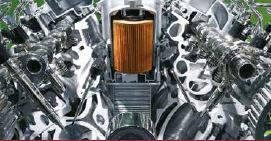Top End

Dirt contamination costs-how to avoid the billHow to spot dirt contamination in engines and ways to counter it. Abrasive dirt is the single biggest cause of engine failure and can damage pistons, piston rings, cylinder bores, crankshafts, bearings, valves, oil seals, the oil pump and the camshaft. Scratched and worn surfaces or surfaces that look as if they have been sandblasted or rubbed down are two identifiable signs of dirt contamination.
ROOT OF THE PROBLEM There are four main sources of dirt contamination:
1. Debris from normal wear and tear Much of this kind of debris is trapped by the oil filter and is removed from the engine during the scheduled oil and filter change. In a well maintained engine, this kind of dirt rarely causes problems.
2. Dirt from the road Although regular scheduled servicing with replacement of air and lubricating oil filters will remove most of this dirt, it is recommended to check the connections between the filters and the engine too. This helps prevent the damaged connection from allowing air that may contain dirt to bypass the filter and be drawn into the engine.
Filters in the fuel breathing and vacuum systems should also be checked as per the vehicle manufacturer’s schedule. Furthermore, dirt entering the engine via the air intake or with contaminated oil can do the most damage to the compression rings and upper ring lands.
3. Built-in dirt A clear indication of existing or residual dirt in the oil galleries is when the crankshaft bearings are scratched or pockmarked while the other components show less damage. The engine can also be contaminated if the re-boring or crankshaft grinding debris is not thoroughly removed. Care should also be taken to keep the engine assembly bench spotlessly clean when parts are lubricated before assembly or they may pick up dirt, which will then be assembled into the engine.
Another clear indication of built-in dirt is when the bearing backs are marked by dirt particles compressed between the crankshaft bearings and their housings as it could not have got past the bearing after assembly.
4. Dirty oil The lubricating oil can get contaminated if kept in a bulk store and then carried to the engine in a dirty container. This kind of contamination usually damages the crankcase components and lower portion of the pistons, whilst leaving the piston upper lands relatively untouched.
A contaminated engine must be thoroughly cleaned and damaged parts re-machined or replaced. A better solution is to prevent the contamination occurring in the first place.
PREVENTION, NOT CURE Steps to ensure contamination does not happen include:
· Adhering to the manufacturer’s recommended service schedules and procedures, especially for replacing air and lubricating oil filters · Maintaining a scrupulously clean engine assembly bench and thorough removal of all re-boring and crankshaft grinding debris · Storing and transporting lubricating oil in spotlessly clean containers
Following these procedures and practices substantially reduces the likelihood of an engine being contaminated to an extent where it could cause serious problems or damage. This will not only keep end-users happy and save workshops time and trouble but could also spare the potential for professional embarrassment.
|
Related Articles Related Downloads |
